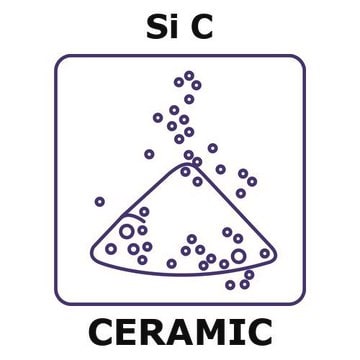GF28127921
Iron
foil, 25x25mm, thickness 0.1mm, hard, 99.5%
Sinónimos:
Iron, FE000320
Iniciar sesiónpara Ver la Fijación de precios por contrato y de la organización
About This Item
Fórmula lineal:
Fe
Número de CAS:
Peso molecular:
55.85
Número MDL:
Código UNSPSC:
12141721
ID de la sustancia en PubChem:
NACRES:
NA.23
Productos recomendados
Ensayo
99.50%
Formulario
foil
fabricante / nombre comercial
Goodfellow 281-279-21
resistividad
9.71 μΩ-cm
tamaño × grosor
252x5 mm × 0.1 mm
bp
2750 °C (lit.)
mp
1535 °C (lit.)
densidad
7.86 g/mL at 25 °C (lit.)
cadena SMILES
[Fe]
InChI
1S/Fe
Clave InChI
XEEYBQQBJWHFJM-UHFFFAOYSA-N
Descripción general
For updated SDS information please visit www.goodfellow.com.
Información legal
Product of Goodfellow
Elija entre una de las versiones más recientes:
Certificados de análisis (COA)
Lot/Batch Number
It looks like we've run into a problem, but you can still download Certificates of Analysis from our Documentos section.
Si necesita más asistencia, póngase en contacto con Atención al cliente
¿Ya tiene este producto?
Encuentre la documentación para los productos que ha comprado recientemente en la Biblioteca de documentos.
Jun-Won Jang et al.
Water science and technology : a journal of the International Association on Water Pollution Research, 59(12), 2503-2507 (2009-06-23)
Zero valent iron has been successfully used for the degradation of a wide range of contaminants. However, this reaction of using ZVI particle produces a large quantity of iron sludge. To solve the problem, we report the synthesis of self-organized
Qiu et al.
Physical review letters, 85(7), 1492-1495 (2000-09-06)
FeF (2) films are grown by the reaction of XeF (2) and SeF (6) with iron foil. The growth initially follows the Mott-Cabrera parabolic rate law, indicating that the process is diffusion limited. At a certain film thickness, however, the
Arnold L Demain et al.
Applied microbiology and biotechnology, 73(1), 55-59 (2006-04-20)
When tetanus toxin is made by fermentation with Clostridium tetani, the traditional source of iron is an insoluble preparation called reduced iron powder. This material removes oxygen from the system by forming FeO(2) (rust). When inoculated in a newly developed
Maria Wilhelm et al.
Clinical nephrology, 81(4), 251-258 (2014-03-25)
Hyperphosphatemia in advanced chronic kidney disease (CKD) necessitates the use of phosphate binders. This in vitro study assessed phosphate binding and Fe release properties of the novel iron-based phosphate binder PA21. Phosphate adsorption and Fe release were assessed under conditions
Antonino Missineo et al.
Infection and immunity, 82(6), 2448-2459 (2014-04-02)
Staphylococcus lugdunensis is a coagulase-negative staphylococcus that is a commensal of humans and an opportunistic pathogen. It can cause a spectrum of infections, including those that are associated with the ability to form biofilm, such as occurs with endocarditis or
Nuestro equipo de científicos tiene experiencia en todas las áreas de investigación: Ciencias de la vida, Ciencia de los materiales, Síntesis química, Cromatografía, Analítica y muchas otras.
Póngase en contacto con el Servicio técnico




